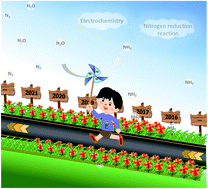Nanomaterials for the electrochemical nitrogen reduction reaction under ambient conditions
Abstract
As an important chemical product and carbon-free energy carrier, ammonia has a wide range of daily applications in several related fields. Although the industrial synthesis method using the Haber–Bosch process could meet production demands, its huge energy consumption and gas emission limit its long-time development. Therefore, the clean and sustainable electrocatalytic N2 reduction reaction (NRR) operating under conditions have attracted great attention in recent years. However, the chemical inertness of N2 molecules makes it difficult for this reaction to proceed. Therefore, rationally designed catalysts need to be introduced to activate N2 molecules. Here, we summarize the recent progress in low-dimensional nanocatalyst development, including the relationship between the structure and NRR performance from both the theoretical and experimental perspectives. Some insights into the development of NRR electrocatalysts from electronic control aspects are provided. In addition, the theoretical mechanisms, reaction pathways and credibility studies of the NRR are discussed. Some challenges and future prospects of the NRR are also pointed out.

- This article is part of the themed collections: Nanocatalysis Beyond CO2 Activation and Recent Review Articles


 Please wait while we load your content...
Please wait while we load your content...